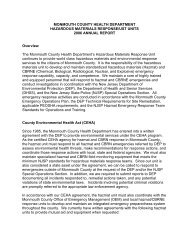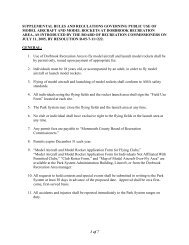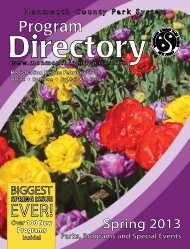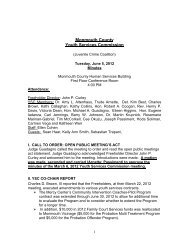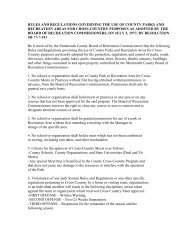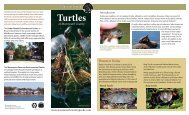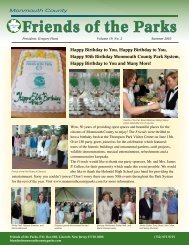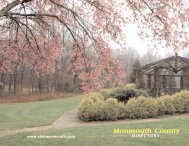Parks 1-10 - Monmouth County
Parks 1-10 - Monmouth County
Parks 1-10 - Monmouth County
- No tags were found...
You also want an ePaper? Increase the reach of your titles
YUMPU automatically turns print PDFs into web optimized ePapers that Google loves.
1. Shark River Park | 1960–24 acres; 2009–957 acresTHIS FIRST <strong>Monmouth</strong> <strong>County</strong> park originated when the N.J. HighwayAuthority completed the Garden State Parkway and declared 24 acresof adjacent land as surplus. The land included part of a former GirlScout camp, fields, and forested wetlands along the Shark River. Withits potential for both recreation and protection of a stream corridor,and its proximity to populated shore towns, <strong>County</strong> leaders consideredit ideal for their first regional park, and they bought it in 1960.In developing Shark River Park, <strong>County</strong> leaders established twoprecedents for their future parks—serving visitors of all age groupsyear round with multiple recreation opportunities and leveraging the<strong>County</strong>’s investment with other resources. Their plan included trailsalong the river, a four-acre pond for fishing and skating, picnic tablesand grills, playing fields, a playground, parking, restrooms, and a shelterbuilding, and they enlisted the State’s Soil Conservation Service to digthe pond and arranged for prisoners to help with the construction.<strong>County</strong> leaders opened the park in 1961 and its immediate popularityled Neptune Township officials to donate 40 acres of adjacent wetlandsand woods to expand the park.In the ensuing five decades, the Park System has expanded SharkRiver Park eastward along both sides of the river, protecting the SharkRiver watershed with additional woods, fields, and wetlands to encompass957 acres, nearly 40 times its original size. It is the now the<strong>County</strong>’s second largest regional park and has nine miles of multi-usetrails for hiking, running, biking, and horseback riding.The park is located on New Jersey’s outer coastal plain where the terrainis generally flat, the soils are sandy remnants of the ancient seabed,and the vegetation represents the northern edge of the New Jersey PineBarrens, an internationally recognized landscape. It is a linear park alongboth sides of the Shark River, with its eastern border near the Shark RiverBasin. The Park and the <strong>County</strong>’s adjacent Shark River Golf Course protectabout 16% of the Shark River watershed.Most of the park is forested and almost half is lowlands. The forestcommunity is typical of the Pine Barrens, with pitch pine dominating,and including red maple and various oak species. Huckleberries and
lueberries provide a low sparse understory in the higher and drierareas, and swamp azalea and southern magnolia grow in lower andwetter areas. Cranberries and sundews thrive in sandy areas with ashallow water table, and Atlantic white cedar woodlands and sphagnummoss hummocks thrive in the saturated lowlands. The core of theforest is relatively undisturbed by invasive species. Three notable plantspecies of local abundance are clubmoss, pink lady’s slipper, and a rareoccurrence of American climbing fern in specific locales.Wildlife within Shark River Park includes bald eagles, barn and greathorned owls, cormorants, great blue and green herons, ospreys, redbats, scarlet tanagers, wood ducks, wild turkeys, coyotes, red foxes, boxand snapping turtles, black racer snakes, and largemouth bass.85———— ——— —————shark river park
2. Holmdel Park | 1962–41 acres; 2009–574 acresWITH its prime location and multiple attractions, Holmdel Park was the <strong>County</strong>’s most visited parkfor four decades and it now competes with the Manasquan Reservoir for that annual distinction.<strong>County</strong> officials established Holmdel Park in 1962 by securing the first Green Acres matching grantin the State to purchase 41 acres of prime farmland from William and Mary J. Riker. The <strong>County</strong> usedGreen Acres matching grants to purchase 131 acres of the adjacent Longstreet Farm from Williamand Mary Holmes Duncan in 1963, and six acres with the historic Longstreet farmstead in 1967.The Park System created hiking trails through the forested portion of the new park, convertedthe old apple orchard to a sledding hill, and the old farm fields to playfields, open lawn, and a picnicarea. The State’s Soil Conservation Service designed a six-acre pond for fishing and skating and<strong>County</strong> prisoners provided some of the general labor for park improvements.The <strong>Monmouth</strong> <strong>County</strong> Shade Tree Commission started a 22-acre arboretum at the south endof the park in 1963 and arranged for Robert B. Clark, the Senior Curator if the L.H. Bailey Hortoriumat Cornell University, to draw up the plans for it. Commission chairman William Duryea and othermembers arranged for local nurseries to donate 87 specimen trees, including crabapples, cherries,and hollies. Since then the Commission has expanded the arboretum to more than 3,000 trees andshrubs, and recently named it the David C. Shaw Arboretum in honor of the superintendent whooversaw it from 1963 to 2002.
88—————— ———— ——holmdel parkLongstreet FarmTHE LONGSTREET FARM homestead is one of the best preservedhistoric farmsteads in New Jersey and one of the Park System’s mostpopular sites, attracting over <strong>10</strong>0,000 visitors a year to see how farmfamilies lived in the 1890s. When English and Dutch immigrants establishedMiddletown around 1680, the Longstreet Farm land was part ofan 1,800-acre plantation settled by Richard Stout, an Englishman, andPenelope Van Princis Stout, his Dutch wife.The central portion of the Longstreet House is the oldest existingstructure on the farm, and was built as a one-and-one-half story Dutch-American House in the mid to late 18th century, probably by Hendrickand Lydia Hendrickson. Their daughter, Williampe, married Aaron Longstreetin 1778, and they built the two-story section before 1798, whenthe Federal Direct Tax assessment for Middletown Township recordedits dimensions and number of windows. They also built the massiveDutch Barn, which the Park System dated through dendrochronologyto 1792. The farm passed down through five generations to MaryLongstreet Holmes, who was born on the farm in 1901 and lived thereher entire life. She and her husband, William Duncan, sold the farm to the<strong>County</strong>. Mary Holmes Duncan lived there until her death in 1977.Park System staff decided to interpret Longstreet Farm to the 1890s,which older members of the <strong>County</strong>’s Agricultural Committee rememberedas a period of major transition as farmers switched from horsesto tractors. Tom Kellers, who was in charge of the interpretation in the1970s, recently recalled that, “barn doors opened up all over the county”and farmers dropped off tools and equipment they had been savingfor decades. The staff opened the Longstreet barn complex in 1971with farm animals and costumed interpreters, and it quickly became apopular attraction for families and school groups. The Park System subsequentlyrestored the Longstreet House to the 1890s and opened it in1983. As farming has continued to disappear, Longstreet Farm provideschildren and adult visitors with an increasingly valuable glimpse into theway people lived off the land in <strong>Monmouth</strong> <strong>County</strong>’s agricultural past.Holmdel Park is on the cuesta or gently-sloping ridge that runs fromHartshorne Woods Park in the northeast corner of the <strong>County</strong> to theClayton Park area in the southwest. It has the largest height variation ofall the <strong>County</strong> <strong>Parks</strong>—from 300 feet above sea level in the Hilltop area,to 70 feet above sea level at the lowest point on the Ramanessin Brook.The park contains the headwaters of the Ramanessin Brook, whichdrains to the Swimming River Reservoir.
About two-thirds of the park is forested, with fields and a six-acrepond on the other third. The old growth upland forest is dominatedby American beech, northern red oak. and tulip poplar trees,and has a sparse understory of American hornbeam trees, mapleleafand arrowwood viburnam shrubs, and Canada mayflowerperennials. Low-lying forested areas are dominated by red mapleand green ash trees, with an understory of spicebush, and skunkcabbagein the more saturated wetlands. The Ramanessin sectioncontains some rare strawberry bush despite the prevalence of deer.Some notable herbaceous plants include foamflower, a rare NewJersey Species, and notable spring ephemerals along the MarshTrail: early meadow rue, round-leaved wintergreen, and roundlobedhepatica.Most of the 182 acres of fields in the park are meadows with warmseasonnative grasses and plants like Goldenrod that provide pleasantvistas and habitat for field-nesting birds and insects. Some of theremaining fields with cool-season grasses are maintained as ‘hay fields,’with infrequent mowing. The two man-made ponds contain stockedtrout, and their shorelines have been planted with native vegetationto provide habitats for butterflies and aquatic insects. Notable wildlifesightings in the park include pileated woodpeckers, great-horned owls,painted turtles, and ring-necked ducks.89—————— —— ————holmdel park
3. Turkey Swamp Park | 1963–272 acres; 2009–2,142 acresTURKEY SWAMP PARK is the <strong>County</strong>’s largest park and together with the adjacent State-owned2,455-acre Turkey Swamp Wildlife Management Area preserves nearly 4,600 acres, the vast majorityin their natural condition, on the northern fringe of the Pine Barrens. The relatively flat area gotits name from the prevalence of wild turkeys and from the high water table that creates swampyconditions in low areas. Native Americans occupied the area because of its abundant wildlife, andEuropean Americans later farmed some of the higher, tillable areas with moderate results.<strong>County</strong> officials used Green Acres matching grants to establish this regional park in 1963 withthe purchase of the 189-acre Bohnke Farm and the adjacent 83-acre Schnitzler property onGeorgia Tavern Road. The Park System created hiking trails and camping and picnicking areas,and used a Federal Land and Water Conservation Fund grant to create a 17-acre lake for boatingand fishing. In a 1978 excavation, archaeologists unearthed Native American artifacts in the Park(pictured right).In 1993, the <strong>County</strong> acquired the adjacent 303-acre Nomoco Camp from the <strong>Monmouth</strong> Councilof Girl Scouts to expand the Park with group camping opportunities.More than 90% of the current acreage in the Park is forested, and a little over half is wetlandthat includes the headwaters of the Manasquan River, the water source for much of southeastern<strong>Monmouth</strong>, and the Metedeconk River, which drains to the Barnegat Bay. The dominant trees
in the Park are red maple, sweet and black gum, shortleaf and pitchpines, and nine species of oaks. Shrubs include sweet pepperbush,blue huckleberry, swamp sweetbells, greenbriar, and blueberry. Twonotable perennials in the Park are the crane-fly orchid, which has leavesin the winter and flowers in the summer, and foxtail clubmoss. Easternred cedars have grown up on the former farm fields along with nativegrasses. The woods turn brilliant red in the fall when blueberries andsweet and black gum change color. Resource management efforts inthe Park include treating for the exotic gypsy moth caterpillars thateach year emerge and eat the oak trees clean of all leaves.The Park and the State’s adjacent Turkey Swamp Wildlife ManagementArea, which includes nearly 4,000 acres of public and privateland, provide a large contiguous habitat for larger wildlife like coyoteand barred, screech and great horned owls, for forest nesting birds likehermit thrush, eastern phoebe, scarlet tanager, and golden-crownedkinglet, and for brown bats and an increasing population of wild turkey.The lake hosts visiting spotted and solitary sandpipers, woodcock,pied-billed grebe, hooded merganser, cormorant, egrets, heron, andbelted kingfisher. An unusual species along the Park’s Metedeconk Trailis the Allegheny mound ant, which builds 5’ wide by 2.5’ tall mounds inthe driest areas so they won’t get flooded in the wet season.91—————— — — —————turkey swamp park
4. Howell Park Golf Course | 1967–302 acres; 2009–311 acresWITH its rustic wooded setting and challenging fairways, Howell ParkGolf Course often seems to the golfers who play there that it musthave started as a private club, but the Park System built the course onthe site of a former farm 40 years ago to meet the growing demand forgolf. Eatontown realtor and golf enthusiast Harold Lindemann thoughtthat the gently rolling fields, good soils, and ponds of the 302-acreWindsor Stock Farm, an old dairy farm in Howell Township, wouldmake a fine golf course, and he recommended to the Freeholders thatthey purchase the property from the Estate of Carl F. Gamer.The Park System commissioned the noted golf course architectFrancis Duane to design the course to be aesthetically pleasing aswell as challenging. Duane earned a degree in landscape architecturefrom Syracuse University and had worked with the famed golf coursearchitect Robert Trent Jones for several years before starting his ownfirm. He designed several public and private courses in Bergen <strong>County</strong>,on Long Island and in upstate New York, and he later collaborated withArnold Palmer on golf courses in South Carolina, California, and Hawaii.For Howell Park, Duane designed an 18-hole, par 72 golf course with6,964 yards of play.According to Dave Pease, the Park System’s General Manager of GolfCourses who began working at the Park System in 1977, the FrancisDuane design at Howell “is second to none with regard to the challengeof the game in a parkland design. The routing of the course, andthe shot making battles that were placed in the design, are extremelychallenging and right on the top of the game. The strength of thecourse and the concepts that were put into it are very unique, andthat’s probably why it has been ranked so high in the public golfcourses in the country, because of its playability as well as the strengthof its design.” Howell Park Golf Course consistently ranks among thetop 50 public golf courses in the country.
In developing the golf course, the Park System preserved about40% of the park land as forest to help protect the Manasquan Riverwatershed. The river runs along the northeast border of the Park, andbeautiful wildflowers bloom along its banks in the spring. The TimberSwamp Brook bisects the course with a pond close to the center ofthe Park and drains to the Manasquan. The forest contains a variety oftrees: sweet and black gum, black walnut, red maple, black cherry, tulippoplar, pitch pine, and red and chestnut oaks. Native shrubs in the Parkinclude sweet pepperbush, mapleleaf and arrowwood viburnum, bluehuckleberry, and serviceberry. Interesting perennials include smoothSolomon’s seal and strawberry bush.The popular Manasquan River Canoe Race, which the Park Systemfirst sponsored in 1970, annually draws many participants to the canoelaunching area in the park.93—————— — — —————howell park golfcourse
5. Thompson Park | 1968–215 acres; 2009–667 acresGERALDINE LIVINGSTON THOMPSON donated 215 acres of Brookdale Farm, one of New Jersey’spremier thoroughbred horse estates, to <strong>Monmouth</strong> <strong>County</strong> when she died in 1967 at the age of95. She first mentioned that she might donate her land for a <strong>County</strong> park and a wildlife sanctuaryin 1957, and later told a reporter, “We’ve got to live with nature. The children have to feel theground beneath them and go out in the woods and see the trees and birds.”Mrs. Thompson’s generous donation included an impressive complex of buildings representingthe multiple owners of the land over three centuries. The oldest house on the property, built byThomas Lloyd in 1786, was the largest house in Middletown Township recorded in the 1798 FederalDirect Tax assessment. David Dunham Withers bought the Lloyd farm in 1872 and establishedthe Brookdale Breeding and Stock Farm there, eventually expanding it to 838 acres that becameknown as the Brookdale Triangle. Withers had amassed a cotton fortune in New Orleans, and afterthe Civil War he returned to New York to pursue his interests in shipping and horse racing. Withersbecame a thoroughbred racing authority, and he bought <strong>Monmouth</strong> Park with some otherbreeders in 1878 and made it one of the country’s pre-eminent race tracks. He employed over<strong>10</strong>0 people at Brookdale Farm, where he built a house for himself, a 300-ft. long training barn, andother barns for his 90 horses, and two race tracks.
95————— —thompsonparkWilliam P. Thompson, who had served as a colonel in the ConfederateArmy and was president of the National Lead Company and a formervice-president of the Standard Oil Company, purchased Brookdale Farmin 1893 and commissioned the noted New York architects Carrere andHastings, designers of the New York Public Library, to expand Withers’house into a Georgian Revival mansion. Thompson was also an authorityon horse racing and bred and trained nearly 200 race horses, includingmany famous ones, at Brookdale Farm. When he died unexpectedly in1896, his son Lewis Steenrod Thompson completed the house and marriedGeraldine Livingston Morgan that same year (mansion, stable handsand 40-stall training barn pictured left in 1906).Geraldine grew up near Hyde Park, New York, where she becamefriends with Franklin D. Roosevelt and his cousin Eleanor Roosevelt, andGeraldine entertained Mrs. Roosevelt at Brookdale Farm on several occasions.Mrs. Thompson was politically active and in 1923 she becamethe first female New Jersey delegate to a Republican National Convention.In 1931 she was the first woman to receive an honorary Masterof Philosophy degree from Rutgers University. Her support of prisonreform, education, public health, and land conservation, includingpreserving Island Beach as a state park, brought her numerous honorsand led many people to call her the “First Lady of <strong>Monmouth</strong> <strong>County</strong>”and “New Jersey’s First Lady.”In 1985, the <strong>County</strong> more than tripled the size of Thompson Parkwith the acquisition of the 334-acre Marlu Farm, which had oncebeen a part of Brookdale Farm, and the adjacent 118-acre CheecaFarm to preserve the land from being developed and to protectthe Swimming River Reservoir. Today, Thompson Park and HolmdelTownship’s 83-acre Cross Farm Park on the east side of LongbridgeRoad protect nearly two miles of shoreline on the north side of theSwimming River Reservoir.
96—————— —thompsonparkBrookdale Farm was for many decades the showplace of <strong>Monmouth</strong><strong>County</strong>’s horse farm estates, and today Thompson Park is the ParkSystem’s headquarters and crown jewel. With 14 miles of trails, soccerand rugby fields, tennis courts, a playground, a fishing lake, an off-leashdog area, the Creative Arts Center, and its many programs and activities,Thompson Park attracted the fourth highest visitation in the ParkSystem in 2009.Reflecting the use of the landscape over three centuries, ThompsonPark today is a mosaic of lawns, specimen estate trees, playing fields,agricultural fields, hedgerows, shrublands, and woods. Almost 75%of the land is open, with about one-third of it maintained as naturalareas, with cool-season grassy fields resembling hayfields and old fieldsdominated by a variety of warm-season native grasses like broomsedgeand little bluestem and other more colorful native perennialslike goldenrod. All these grassy fields provide a pastoral contrast tothe formal lawns and grounds of the old estate and the park facilities.About one-quarter of the open areas are agricultural fields leased tofarmers, another quarter are open play fields, and about <strong>10</strong>% are formalathletic fields. Park ecologists are managing several ongoing restorationprojects to remove invasive species, promote reforestation, andnurture old fields and mature woodlands in the Park.
Geraldine Thompson wanted her land to be a sanctuary for birds,and she would be pleased to see the many species of birds in the Parktoday. The grassy fields provide habitat for flying insect feeders likeeastern bluebirds and purple martins and for field-dependent birds likeharriers, meadowlarks, and sparrows. Other notable field birds in thePark include cedar waxwing, eastern kingbird, indigo bunting, sand hillcrane, sharp-shinned hawk, and Coopers hawk. Hedgerows and estateand farm trees around the Park provide foraging and resting areas formany birds, especially during migration periods, including some occasionalor rare species like northern shrike, yellow-billed cuckoo, andblue grosbeak.The wooded 25% of the Park includes remnants of old growthforest, which has remained forest for at least 150 years, with stands ofAmerican beech and red, white and black oak, and an understory ofmaple-leaf viburnum and in some areas mountain laurel. The <strong>10</strong>-acreforest on the Cheeca Farm includes shagbark hickory and Americanelm, and a great horned owl pair often utilize these woods for breeding.A large area of trout lily wildflowers provides an attractive springdisplay in the woods along the reservoir. The forested areas andgrounds also host screech owl, common redpoll, great horned owl,hooded warbler, orchard oriole, pine warbler, and foraging bald eagle,and wetland areas host clapper rail, glossy ibis, lesser yellowlegs, andgreater yellowlegs.The expansion of the Swimming River Reservoir in the 1960s and theformation of the 22-acre Marlu Lake from the flooding of Borden’s Brookhave created some significant water habitat for notable species like theAmerican bittern, a bird of the heron family that wades along the forestedshorelines, and bald eagles that nest and forage in the vicinity.
6. Baysholm Tract | 1969–35 acres; 2009–71 acresGERALDINE THOMPSON’S donation of Brookdale Farm to the Park System in 1967may have inspired Helen Hermann of West Long Branch to donate Baysholm, herfarm in northwest Freehold Township. Miss Hermann was born in 1902 in Manhattanand grew up spending summers with her family in the Elberon section of LongBranch, where she became an avid tennis player. She attended Bryn Mawr College,where she excelled in math, earned a master’s degree at Columbia University, andlater worked for Franklin Delano Roosevelt. She never married but volunteered formany years to help children, and she co-founded the Children’s Psychiatric Center,which is now CPC Behavioral Healthcare in Eatontown. She left half of her substantialestate to the organization, which named its Helen Hermann Counseling Centerin Red Bank and its annual Helen Hermann Community Service Award in her honor.In 1946, Miss Hermann (pictured right) bought the 71-acre William Wikoff Farmin Freehold Township and named it Baysholm from an Old English word for ‘youngcalves meadow.’ Miss Hermann operated the farm until she donated half of it to thePark System in 1969, and she donated the other half in 1973 (farm in 1969, lower right).The Baysholm Tract protects the headwaters of a tributary of the Yellow Brook,which drains into the Swimming River Reservoir. The land is relatively flat andcontains about 12.5 acres of wooded wetlands along the tributary. The remainder isabout equally divided between leased farm fields and young forest that has grownup since farming was discontinued.
7. Durand Tract | 1969–90 acres; 2009–94 acresIN THE SAME YEAR that Helen Hermann donated half of Baysholm Farm to thePark System, her Freehold Township neighbor one-half mile to the north, ElizabethDurand, donated 90 acres of her farm on Randolph Road to the Park System, whileretaining her residence on a separate lot. Freehold Township purchased 88 acresof adjacent farmland in 1984 and leased the Durand tract the following year fromthe Park System so that it could manage the entire 178 acres for conservation andpassive recreation. Township officials established the Freehold Township MemorialArboretum at Durand on 3.5 acres in 1991, and it has now grown to 33 acres. TheTownship also maintains a 20-acre Butterfly Meadow planted with native grasses andwildflowers to attract butterflies.About 60% of the Durand Tract consists of old farm fields that are still farmed today.A 3.5-acre pond created around 1960 and the upper reaches of the Yellow Brookthat flows through the Park provide some water habitat. The remainder of the landis forest that has grown up where farming was gradually abandoned in the secondhalf of the 20th century.
for a new place to hold the Fair, the East Freehold Showgroundsprovided an ideal location, and collaboration with the Park Systembrought the Fair to a new level of public participation. More than9,000 people attended the first fair at East Freehold in 1975 andmore than 68,500 attended the 35th Fair there in 2009. Each year aPark System manager chairs the Fair, and many employees devotethemselves to making the Fair one of the most popular events inthe <strong>County</strong>.The Park System hosted the Park’s first dog show in 1982, anddog shows have grown increasingly popular there since. The <strong>Monmouth</strong><strong>County</strong> Kennel Club’s annual dog show on Memorial DayWeekend attracts thousands to the Park.The <strong>County</strong> added 20 acres to the Park in 1983 and has plantedshade trees and installed picnic tables that attract many visitorseven when there are no events taking place. A tributary of theDeBois Creek, which drains to the Manasquan River, runs along thenorthern and western boundaries of the site. The Park’s good soilsand its proximity to the population center of Freehold Boroughmake it ideal for recreation.<strong>10</strong>1



